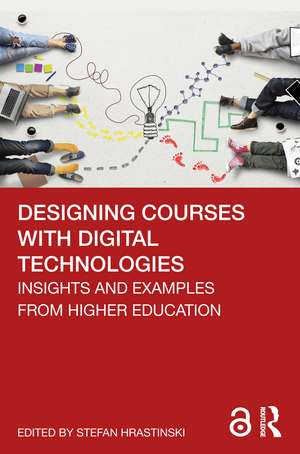Designing Courses with Digital Technologies: Insights and Examples from Higher Education
Editat de Stefan Hrastinskien Limba Engleză Paperback – 3 aug 2021
Chapter 6 of this book is freely available as a downloadable Open Access PDF at http://www.taylorfrancis.com under a Creative Commons Attribution-Non Commercial-No Derivatives (CC-BY-NC-ND) 4.0 license.
| Toate formatele și edițiile | Preț | Express |
|---|---|---|
| Paperback (1) | 344.75 lei 6-8 săpt. | |
| Taylor & Francis – 3 aug 2021 | 344.75 lei 6-8 săpt. | |
| Hardback (1) | 1000.27 lei 6-8 săpt. | |
| Taylor & Francis – 3 aug 2021 | 1000.27 lei 6-8 săpt. |
Preț: 344.75 lei
Nou
Puncte Express: 517
Preț estimativ în valută:
65.97€ • 69.05$ • 54.91£
65.97€ • 69.05$ • 54.91£
Carte tipărită la comandă
Livrare economică 31 martie-14 aprilie
Preluare comenzi: 021 569.72.76
Specificații
ISBN-13: 9780367700003
ISBN-10: 036770000X
Pagini: 184
Dimensiuni: 152 x 229 x 10 mm
Greutate: 0.34 kg
Ediția:1
Editura: Taylor & Francis
Colecția Routledge
Locul publicării:Oxford, United Kingdom
ISBN-10: 036770000X
Pagini: 184
Dimensiuni: 152 x 229 x 10 mm
Greutate: 0.34 kg
Ediția:1
Editura: Taylor & Francis
Colecția Routledge
Locul publicării:Oxford, United Kingdom
Public țintă
Academic, Professional, and Professional Practice & DevelopmentNotă biografică
Stefan Hrastinski is Professor in the Division of Digital Learning and Director of Research Education in the Department of Learning in Engineering Sciences at KTH Royal Institute of Technology, Sweden.
Cuprins
Introduction
Stefan Hrastinski, KTH Royal Institute of Technology
Section A: Discussion forums and blogs
- Discussion forums in literature and film
Carolina Leon Vegas, Dalarna University - Discussion forums in management
Richard Cotterill, University of York - Knowledge construction through blogs
Maria Limniou, University of LiverpoolSection B: Collaboration - Online pair programming
David Parsons, Darcy Vo, Karen Lambrechts, The Mind Lab - Digital collaboration tools
Eric Loepp, Nicole Weber, University of Washington Whitewater - Problem-based learning in international online groups
Alastair Creelman, Linnaeus University, Maria Kvarnström, Linköping University, Jörg Pareigis, Karlstad University, Lars Uhlin, Linköping University, Lotta Åbjörnsson, Lund UniversitySection C: Collaborative writing and reading - Collaborative writing in group work
Katarina Lindahl, Dalarna University - Collaborative writing in the classroom
Angel Fan, The Chinese University of Hong Kong, Angela Daly, University of Strathclyde - Contributing to public debate through collaborative writing
Patric Wallin, Norwegian University of Science and Technology - Collaborative annotation to support students’ online reading skills
Matt East, Talis, Hope Williard, Jamie Wood, University of LincolnSection D: Group work - Students as content creators
Jane Guiller, John Smith, Glasgow Caledonian University - Virtual teams
Ann-Sofie Hellberg, Jonas Moll, Örebro UniversitySection E: Flipped classroom - Teaching Mandarin vocabulary using a flipped approach
Xinyi Tan, Coastal Carolina University - Flipped math teaching in diagnostic medicine
Bei Zhang, University of Vermont - Flipping an online module in computational physics
Christophe Demazière, Tom Adawi, Christian Stöhr, Chalmers University of TechnologySection F: Video - Video assignments
BethAnne Paulsrud, David Gray, Katherina Dodou, Dalarna University - Interactive videos
Rob Lowney, Maria Loftus, Dublin City University - Authentic vlogs
Felicity Healey-Benson, University of WalesSection G: Video conference - Relation building in break out groups
Kristin Landrø, Camilla Hellesøy Krogstie, Gunhild Marie Roald, Patric Wallin, Norwegian University of Science and Technology - Using video conference for group problem solving
Siming Guo, Coastal Carolina University - Recording synchronous online teaching to develop practice
Tim Gander, The Mind LabSection H: Student induction and responsive teaching - Student-generated induction in a lecture theatre
Nicholas Bowskill, University of Derby - Pre-class surveys to inform course design
Angela van Barneveld, Helen DeWaard, Lakehead University
Descriere
Written by and for instructors from a variety of disciplines, this book presents evaluations that the contributors have implemented in real-life courses, spanning blended and distance learning, flipped classrooms, collaborative technologies, video-supported learning, and beyond.
